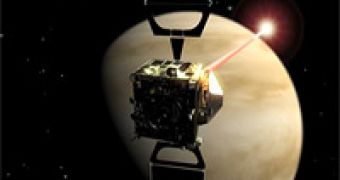A new method to study the properties of planets outside the solar system has been proposed by Jean-Loup Bertaux from the Service d'Aeronomie du CNRS. The technique is known as stellar occultation and France has suggested using it in ESA missions to study the planetary systems.
The phenomenon occurs when light from a star is blocked by a body such as a planet, moon or asteroid. The method can be used to probe ring systems and atmospheres. Occultation studies allow detailed observations of the temperature, pressure and density profiles in the upper atmosphere of the large planets such as Jupiter and Saturn.
Light shining above the atmosphere of a planet gives off radiation across a large range of wavelengths. As the planet orbits the star, it passes in front of it blocking partially the light that it gives off; part of the light is filtered through the planet's atmosphere narrowing and blocking some of the wavelengths of the star's radiation. By studying the blocked wavelengths, scientists can determine what kind of molecules and atoms are present in the planet's atmosphere.
The same technique is presently used by ESA to study three different planets with the help of three spacecrafts positioned in their orbit. Also around the Earth an instrument called GOMOS or Global Ozone Monitoring by Occultation of Stars, part of ESA's Envisat mission, is studying the quality of the ozone layer after the ban of harmful chemicals. It has studied the light coming from about 400 stars to create a map of Earth's atmosphere at all latitudes and longitudes.
The data supplied can not yet evaluate the condition of the ozone layer and whether it is recovering or not, more phenomena are discovered that contribute to the amount of ozone in the atmosphere. The ozone layer can be destroyed by nitrogen dioxide gas and it is important to trace it. As it was observing Earth's atmosphere, GOMOS discovered in February 2004 a large nitrogen dioxide gas build up at an altitude of 65 kilometers, in the next months descending to 45 kilometers.
In 2003 ESA put on Mars' orbit an instrument, named SPICAM or Spectroscopy for Investigation of Characteristics of the Atmosphere of Mars and has observed over 1000 stellar occultations since then, which provided crucial data in understanding the upper atmosphere of Mars that could prove beneficial for future space exploration missions. A similar spacecraft is placed in the orbit of Venus. SPICAV revealed that Venus has a different atmosphere from Earth and Mars.

 14 DAY TRIAL //
14 DAY TRIAL //